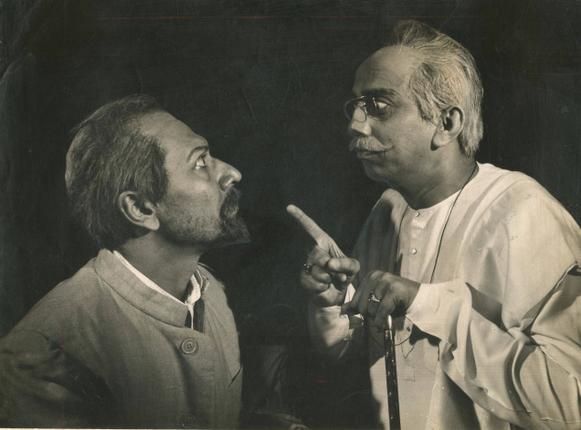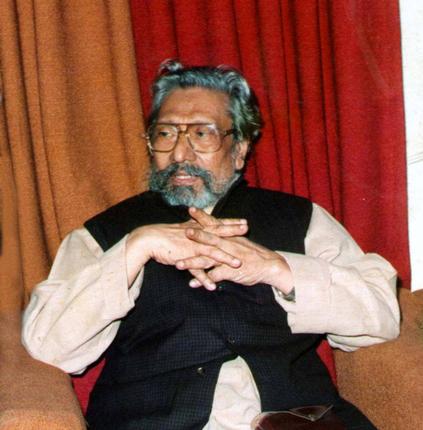
As a festival commemorating Sombhu Mitra’s birth centenary gets underway in the Capital, former associates of the iconic theatre artist speak about his contribution.
Sombhu Mitra, in his acceptance speech for the Magsaysay Award, spoke of the artistic urge in human beings that separated them from other species: “…it is in the nature of man that he is compulsively driven to overcome the dictates of mere convenience. In the early days of civilization, as he needed to draw water, he invented the urn. The urn was filled, but not his heart. So he began now to decorate it with colour, geometric patterns, and his imagination. What an incomprehensible and strange craving!”
Perhaps it was this belief, and a recognition of his own “incomprehensible and strange craving” that led him to break away from the idealistic and message driven plays of the Indian People’s Theatre Association, and in 1948, to found Bohurupee along with Bijon Bhattacharya and other associates in Calcutta.
Bohurupee was a pioneering theatre group as it represented the individual artistic quest, perhaps what could be called the middle ground between commercial theatre and those productions whose underlying aim was to raise awareness among the masses.
“For him theatre was high art,” feels Raka Chakravarty, who from childhood had a chance to observe the philosophy and working style of the icon. “It was not to be used like street theatre or for propaganda. It was pure art, and for that of course he selected the best of plays.”
Raka’s father, eminent journalist Prithvis Chakravarti, is credited with bringing Bohurupee to Delhi for the first time. The occasion was the National Theatre Festival held at the All India Fine Arts and Crafts Society (AIFACS) in 1956, and Chakravarty was one of the event’s main movers. “In fact this was the inaugural event of AIFACS,” recalls Raka.
There was another significance to the occasion. Charles Fabri, the highly influential critic whose writings in newspapers including The Statesman moulded public opinion nationally and internationally, was convinced that contemporary Indian theatre had no identity of its own and the productions being done were either mythological or historical plays or merely adaptations of Western theatre. On the other hand, Bengali artists and thinkers were sure that the works of Rabindranath Tagore, imbued with the spirit of India, were not stageable. Mitra’s path-breaking production of Tagore’s “Rakta Karabi” demolished both these notions. Chakravarti and Fabri had laid a wager, says Raka, and Fabri had to accept the worth of Indian theatre when “Rakta Karabi” was presented by Bohurupee at the 1956 festival.
Bohurupee performed two productions, “Rakta Karabi” and “Chhenra Taar”, and both were so excellent it was difficult for the jury to decide which should be given the top prize, she notes.
Well known theatre director Kirti Jain, former Director of the National School of Drama, also looked to ‘Sombhu da’ as an avuncular figure. She too grew up in the benevolent ambience of friendship shared by her parents — Nemichandra Jain and Rekha Jain — with Sombhu da and his wife the celebrated actress Tripti Mitra.
Conversations between Kirti’s father and Mitra would range from philosophy to mathematics, language and semiotics to politics. “He could create in you a curiosity about so many things. That kind of range I saw in my father too,” she says. “I found that very fascinating. It was more than theatre; it was a whole way of life. And that entire generation had it, though of course Sambhu da was special.”

On her own interactions with Mitra, she says, “For me, it was like hero worship, someone you could look up to in theatre. It was nice to have that access to him through my parents.”
Her last interaction with him was a professional one, where she interviewed him for a film. “That interview wasn’t as warm as I had expected,” she recalls. Since at home, “it was always laughing and talking, and food, and making fun of the food, and all that happens in a home,” she had thought that her involvement in the interview would ensure a measure of informality, but this did not happen. “Maybe because he wanted it to be formal,” she muses.
But the reason could also have been his fierce conviction regarding his work. Raka too knew the difference between Mitra’s personal and directorial personas. The Chakravartys would spend summer vacations in Kolkata, and regular visits to Bohurupee to listen to play readings were a memorable feature of these holidays. “He (Mitra) was a family friend and one was not in awe of him,” notes Raka, “but there, he was like an emperor!”
Averee Chaurey, who acted under Mitra’s direction in significant roles as a youngster in Kolkata, while referring to him as “amazing,” admits that he was “aloof, not paternal”, and “never allowed anybody else to direct.” Mitra had “a great intellect and could recite a hundred poems at a time,” says Averee.
Punctuality was non-negotiable. Anyone who came even five minutes late would not be allowed into the rehearsal. Kumar Roy, who took over the reigns after Mitra left Bohurupee, was “paternal”, she adds. However, the group continued to follow Mitra’s philosophy. “We had body movement and voice training, we learnt the harmonium and singing and poetry recitation.”
If the discipline Mitra inculcated has remained to this day in the theatre artists he moulded, he also brought out unexpected talents. Rekha Jain was married as a child to Nemichandra Jain. Joining IPTA, Calcutta, with her husband, she found herself for the first time expected to sing and dance and act. Her first role was in the Hindi version of “Navanna”.
“My father had translated it (into Hindi) and Sombhu da was directing it. My mother was from a very conservative family. She had to play the role of a woman who because of poverty takes to prostitution. She used to tell us about how Sombhu da got her out of that embarrassment.”
Mitra was also a formidable actor. Kirti recalls seeing him as Chanakya in “Mudrarakshas”. There was excitement around the production as he was returning to the stage after a gap. The audience had yet to settle down when the play started. “Sombhu da was speaking. And suddenly he stopped, and looked from one end of the auditorium to the other, and there was pin drop silence!”
Such was the command of the man who was among the pioneers of group theatre in India, who believed in stories of the common people, for the common people.
Impresario India presents “Salute to you, O Creative Genius” . August 22, India Habitat Centre, 7 p.m.; August 23 & 24, Azad Bhawan, Indian Council for Cultural Relations, 6 p.m.; August 27, India International Centre, 6.30 p.m.
For enquires, call 9811763534, 98111209
source: http://www.thehindu.com / The Hindu / Home> Features> Friday Review / by Anjana Rajan / New Delhi – August 21st, 2014